BESC1490 Introduction to Psychology Assignment: Learning Theories
VerifiedAdded on 2022/10/12
|9
|1819
|188
Homework Assignment
AI Summary
This psychology assignment comprehensively addresses various learning theories, including habituation, classical conditioning, operant conditioning, and social learning. Task A defines learning and habituation, explains classical conditioning principles (neutral, unconditioned, conditioned stimuli/responses), and details operant conditioning (positive/negative reinforcement, punishment) and social learning (latent, insight, modeling). Task B delves into the theories, requiring definitions, explanations, and practical applications to real-life scenarios, such as habituation to noise, classical conditioning examples, and learned helplessness. Task C applies the habituation concept to a personal experience, illustrating its impact on overcoming challenges, referencing relevant academic sources to support the analysis and conclusions drawn. The assignment demonstrates a strong understanding of psychological concepts and their practical application.
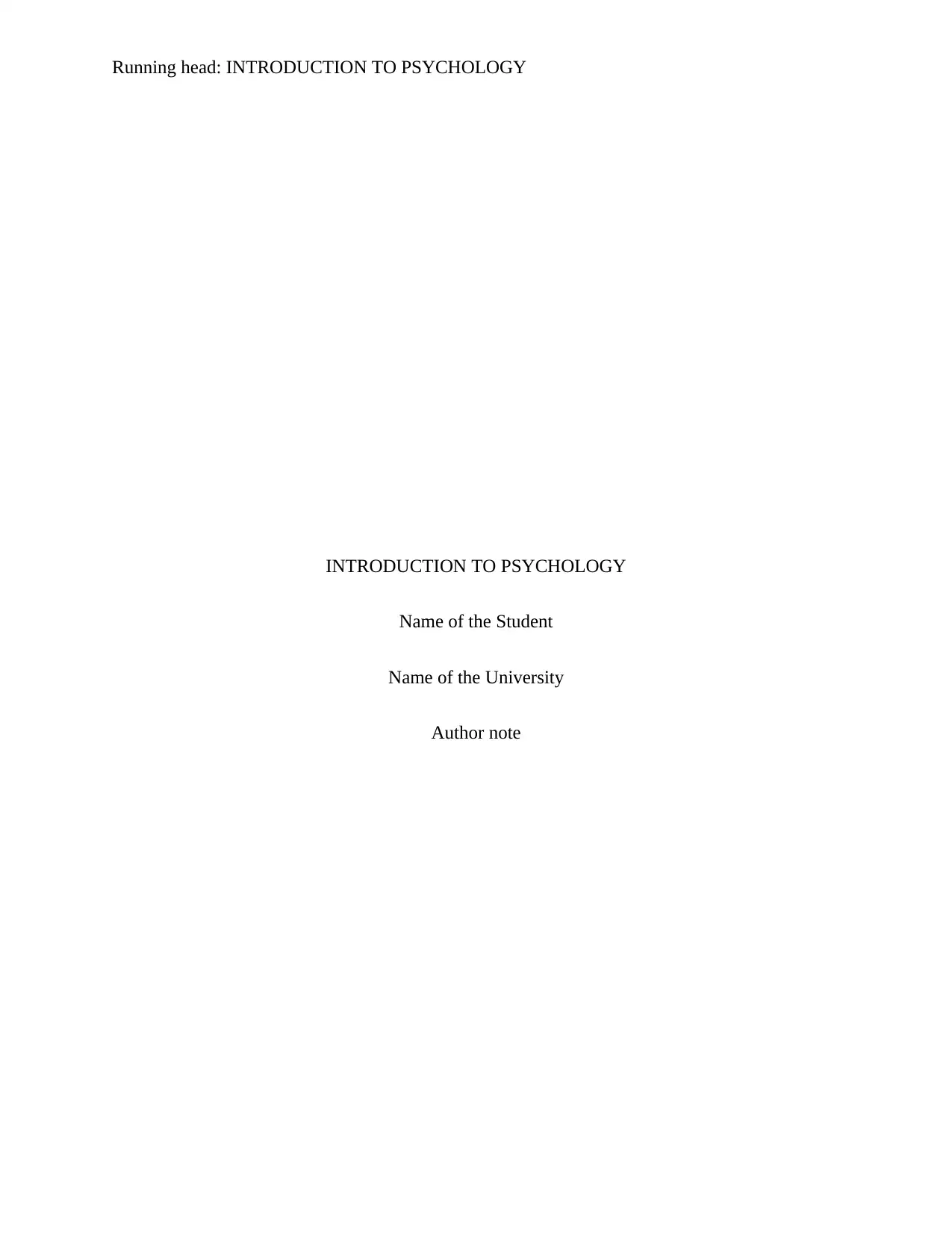
Running head: INTRODUCTION TO PSYCHOLOGY
INTRODUCTION TO PSYCHOLOGY
Name of the Student
Name of the University
Author note
INTRODUCTION TO PSYCHOLOGY
Name of the Student
Name of the University
Author note
Paraphrase This Document
Need a fresh take? Get an instant paraphrase of this document with our AI Paraphraser
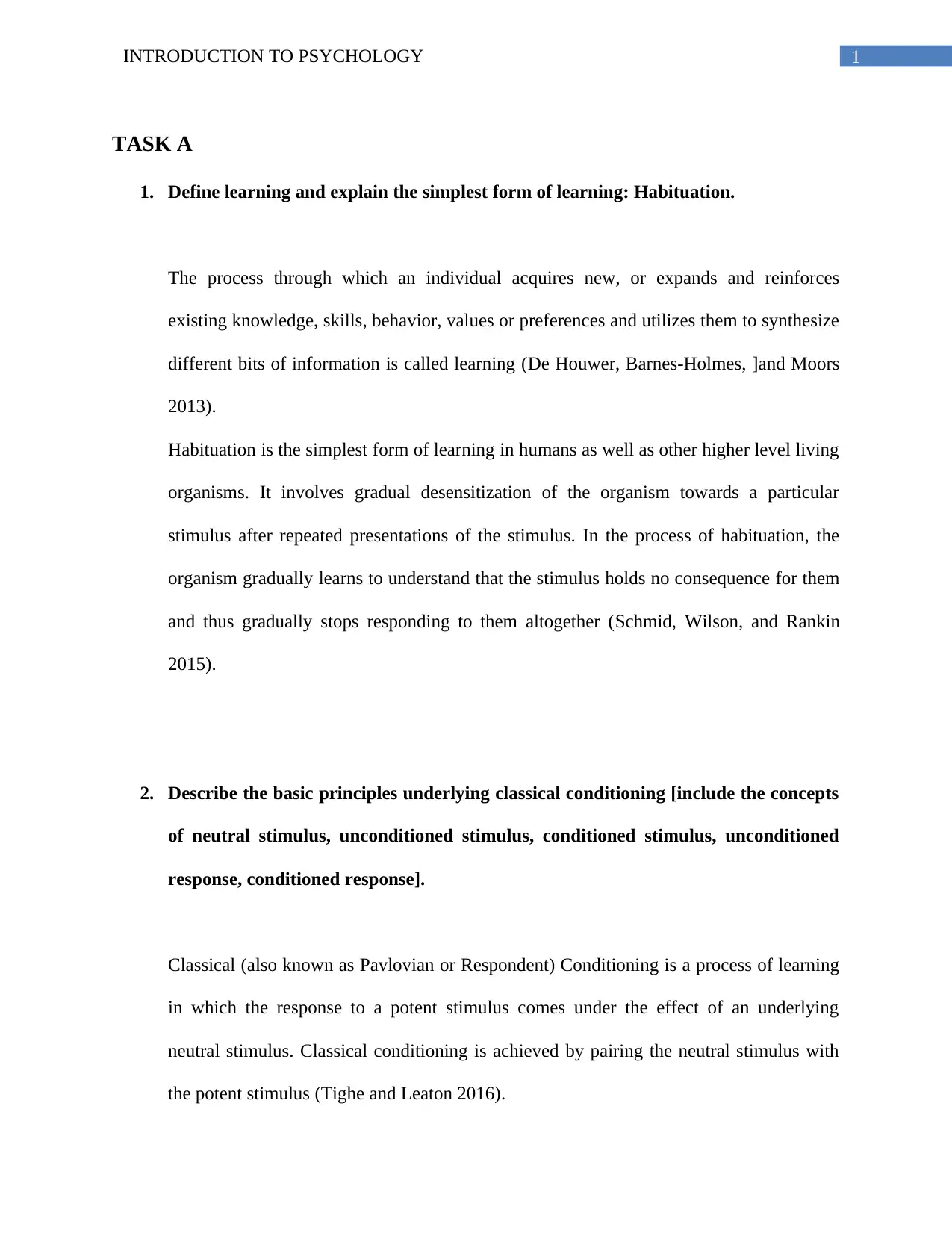
1INTRODUCTION TO PSYCHOLOGY
TASK A
1. Define learning and explain the simplest form of learning: Habituation.
The process through which an individual acquires new, or expands and reinforces
existing knowledge, skills, behavior, values or preferences and utilizes them to synthesize
different bits of information is called learning (De Houwer, Barnes-Holmes, ]and Moors
2013).
Habituation is the simplest form of learning in humans as well as other higher level living
organisms. It involves gradual desensitization of the organism towards a particular
stimulus after repeated presentations of the stimulus. In the process of habituation, the
organism gradually learns to understand that the stimulus holds no consequence for them
and thus gradually stops responding to them altogether (Schmid, Wilson, and Rankin
2015).
2. Describe the basic principles underlying classical conditioning [include the concepts
of neutral stimulus, unconditioned stimulus, conditioned stimulus, unconditioned
response, conditioned response].
Classical (also known as Pavlovian or Respondent) Conditioning is a process of learning
in which the response to a potent stimulus comes under the effect of an underlying
neutral stimulus. Classical conditioning is achieved by pairing the neutral stimulus with
the potent stimulus (Tighe and Leaton 2016).
TASK A
1. Define learning and explain the simplest form of learning: Habituation.
The process through which an individual acquires new, or expands and reinforces
existing knowledge, skills, behavior, values or preferences and utilizes them to synthesize
different bits of information is called learning (De Houwer, Barnes-Holmes, ]and Moors
2013).
Habituation is the simplest form of learning in humans as well as other higher level living
organisms. It involves gradual desensitization of the organism towards a particular
stimulus after repeated presentations of the stimulus. In the process of habituation, the
organism gradually learns to understand that the stimulus holds no consequence for them
and thus gradually stops responding to them altogether (Schmid, Wilson, and Rankin
2015).
2. Describe the basic principles underlying classical conditioning [include the concepts
of neutral stimulus, unconditioned stimulus, conditioned stimulus, unconditioned
response, conditioned response].
Classical (also known as Pavlovian or Respondent) Conditioning is a process of learning
in which the response to a potent stimulus comes under the effect of an underlying
neutral stimulus. Classical conditioning is achieved by pairing the neutral stimulus with
the potent stimulus (Tighe and Leaton 2016).
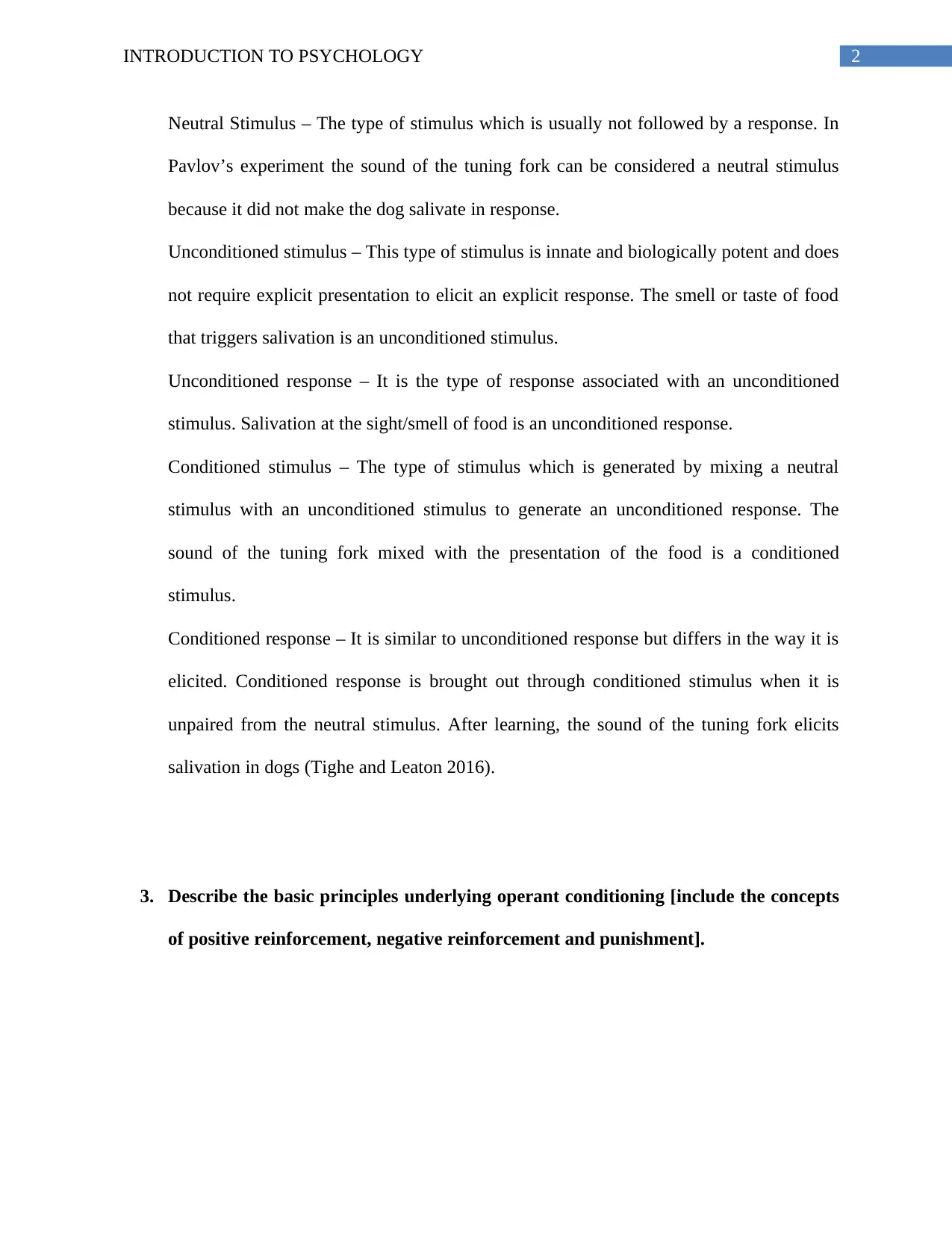
2INTRODUCTION TO PSYCHOLOGY
Neutral Stimulus – The type of stimulus which is usually not followed by a response. In
Pavlov’s experiment the sound of the tuning fork can be considered a neutral stimulus
because it did not make the dog salivate in response.
Unconditioned stimulus – This type of stimulus is innate and biologically potent and does
not require explicit presentation to elicit an explicit response. The smell or taste of food
that triggers salivation is an unconditioned stimulus.
Unconditioned response – It is the type of response associated with an unconditioned
stimulus. Salivation at the sight/smell of food is an unconditioned response.
Conditioned stimulus – The type of stimulus which is generated by mixing a neutral
stimulus with an unconditioned stimulus to generate an unconditioned response. The
sound of the tuning fork mixed with the presentation of the food is a conditioned
stimulus.
Conditioned response – It is similar to unconditioned response but differs in the way it is
elicited. Conditioned response is brought out through conditioned stimulus when it is
unpaired from the neutral stimulus. After learning, the sound of the tuning fork elicits
salivation in dogs (Tighe and Leaton 2016).
3. Describe the basic principles underlying operant conditioning [include the concepts
of positive reinforcement, negative reinforcement and punishment].
Neutral Stimulus – The type of stimulus which is usually not followed by a response. In
Pavlov’s experiment the sound of the tuning fork can be considered a neutral stimulus
because it did not make the dog salivate in response.
Unconditioned stimulus – This type of stimulus is innate and biologically potent and does
not require explicit presentation to elicit an explicit response. The smell or taste of food
that triggers salivation is an unconditioned stimulus.
Unconditioned response – It is the type of response associated with an unconditioned
stimulus. Salivation at the sight/smell of food is an unconditioned response.
Conditioned stimulus – The type of stimulus which is generated by mixing a neutral
stimulus with an unconditioned stimulus to generate an unconditioned response. The
sound of the tuning fork mixed with the presentation of the food is a conditioned
stimulus.
Conditioned response – It is similar to unconditioned response but differs in the way it is
elicited. Conditioned response is brought out through conditioned stimulus when it is
unpaired from the neutral stimulus. After learning, the sound of the tuning fork elicits
salivation in dogs (Tighe and Leaton 2016).
3. Describe the basic principles underlying operant conditioning [include the concepts
of positive reinforcement, negative reinforcement and punishment].
⊘ This is a preview!⊘
Do you want full access?
Subscribe today to unlock all pages.

Trusted by 1+ million students worldwide
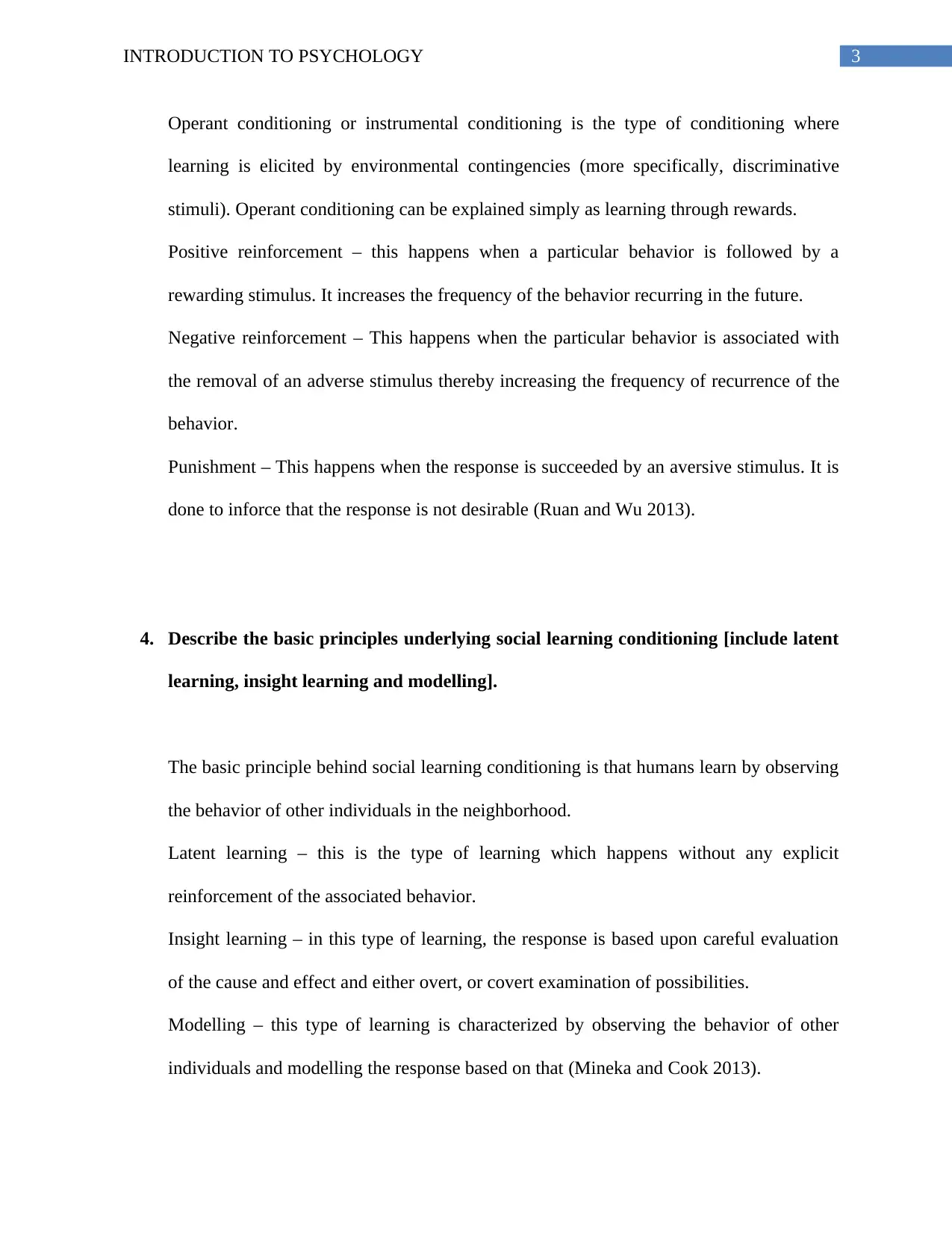
3INTRODUCTION TO PSYCHOLOGY
Operant conditioning or instrumental conditioning is the type of conditioning where
learning is elicited by environmental contingencies (more specifically, discriminative
stimuli). Operant conditioning can be explained simply as learning through rewards.
Positive reinforcement – this happens when a particular behavior is followed by a
rewarding stimulus. It increases the frequency of the behavior recurring in the future.
Negative reinforcement – This happens when the particular behavior is associated with
the removal of an adverse stimulus thereby increasing the frequency of recurrence of the
behavior.
Punishment – This happens when the response is succeeded by an aversive stimulus. It is
done to inforce that the response is not desirable (Ruan and Wu 2013).
4. Describe the basic principles underlying social learning conditioning [include latent
learning, insight learning and modelling].
The basic principle behind social learning conditioning is that humans learn by observing
the behavior of other individuals in the neighborhood.
Latent learning – this is the type of learning which happens without any explicit
reinforcement of the associated behavior.
Insight learning – in this type of learning, the response is based upon careful evaluation
of the cause and effect and either overt, or covert examination of possibilities.
Modelling – this type of learning is characterized by observing the behavior of other
individuals and modelling the response based on that (Mineka and Cook 2013).
Operant conditioning or instrumental conditioning is the type of conditioning where
learning is elicited by environmental contingencies (more specifically, discriminative
stimuli). Operant conditioning can be explained simply as learning through rewards.
Positive reinforcement – this happens when a particular behavior is followed by a
rewarding stimulus. It increases the frequency of the behavior recurring in the future.
Negative reinforcement – This happens when the particular behavior is associated with
the removal of an adverse stimulus thereby increasing the frequency of recurrence of the
behavior.
Punishment – This happens when the response is succeeded by an aversive stimulus. It is
done to inforce that the response is not desirable (Ruan and Wu 2013).
4. Describe the basic principles underlying social learning conditioning [include latent
learning, insight learning and modelling].
The basic principle behind social learning conditioning is that humans learn by observing
the behavior of other individuals in the neighborhood.
Latent learning – this is the type of learning which happens without any explicit
reinforcement of the associated behavior.
Insight learning – in this type of learning, the response is based upon careful evaluation
of the cause and effect and either overt, or covert examination of possibilities.
Modelling – this type of learning is characterized by observing the behavior of other
individuals and modelling the response based on that (Mineka and Cook 2013).
Paraphrase This Document
Need a fresh take? Get an instant paraphrase of this document with our AI Paraphraser
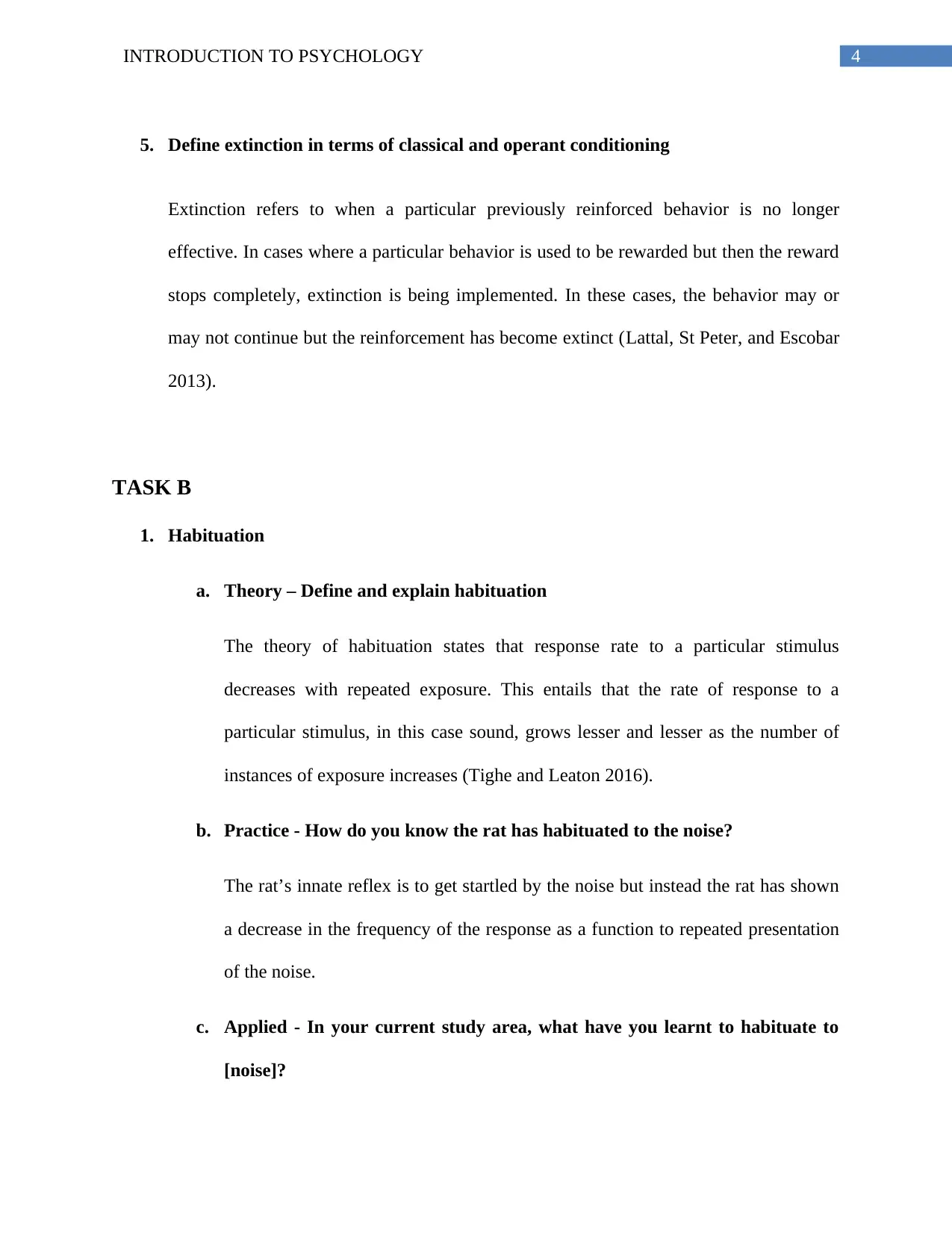
4INTRODUCTION TO PSYCHOLOGY
5. Define extinction in terms of classical and operant conditioning
Extinction refers to when a particular previously reinforced behavior is no longer
effective. In cases where a particular behavior is used to be rewarded but then the reward
stops completely, extinction is being implemented. In these cases, the behavior may or
may not continue but the reinforcement has become extinct (Lattal, St Peter, and Escobar
2013).
TASK B
1. Habituation
a. Theory – Define and explain habituation
The theory of habituation states that response rate to a particular stimulus
decreases with repeated exposure. This entails that the rate of response to a
particular stimulus, in this case sound, grows lesser and lesser as the number of
instances of exposure increases (Tighe and Leaton 2016).
b. Practice - How do you know the rat has habituated to the noise?
The rat’s innate reflex is to get startled by the noise but instead the rat has shown
a decrease in the frequency of the response as a function to repeated presentation
of the noise.
c. Applied - In your current study area, what have you learnt to habituate to
[noise]?
5. Define extinction in terms of classical and operant conditioning
Extinction refers to when a particular previously reinforced behavior is no longer
effective. In cases where a particular behavior is used to be rewarded but then the reward
stops completely, extinction is being implemented. In these cases, the behavior may or
may not continue but the reinforcement has become extinct (Lattal, St Peter, and Escobar
2013).
TASK B
1. Habituation
a. Theory – Define and explain habituation
The theory of habituation states that response rate to a particular stimulus
decreases with repeated exposure. This entails that the rate of response to a
particular stimulus, in this case sound, grows lesser and lesser as the number of
instances of exposure increases (Tighe and Leaton 2016).
b. Practice - How do you know the rat has habituated to the noise?
The rat’s innate reflex is to get startled by the noise but instead the rat has shown
a decrease in the frequency of the response as a function to repeated presentation
of the noise.
c. Applied - In your current study area, what have you learnt to habituate to
[noise]?
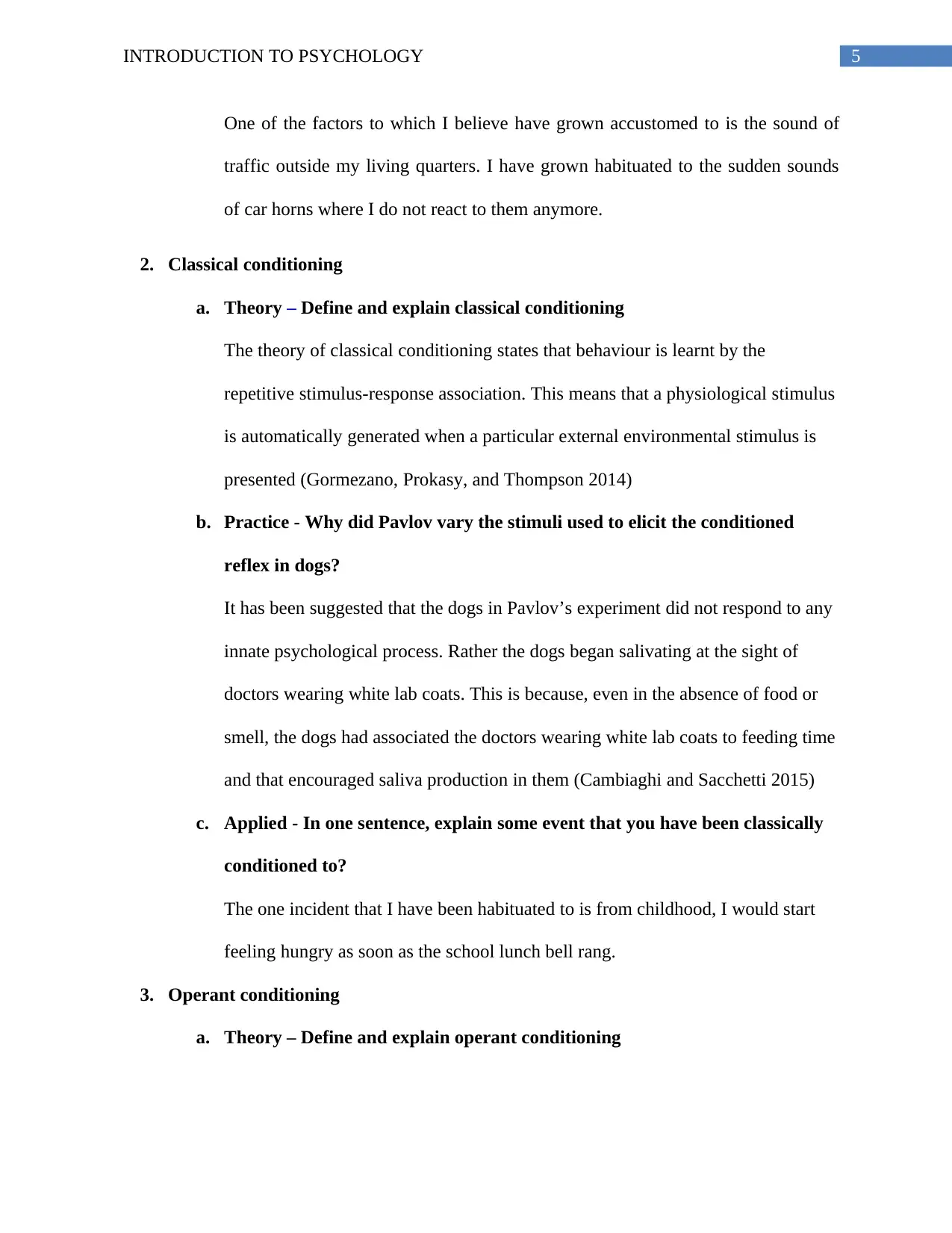
5INTRODUCTION TO PSYCHOLOGY
One of the factors to which I believe have grown accustomed to is the sound of
traffic outside my living quarters. I have grown habituated to the sudden sounds
of car horns where I do not react to them anymore.
2. Classical conditioning
a. Theory – Define and explain classical conditioning
The theory of classical conditioning states that behaviour is learnt by the
repetitive stimulus-response association. This means that a physiological stimulus
is automatically generated when a particular external environmental stimulus is
presented (Gormezano, Prokasy, and Thompson 2014)
b. Practice - Why did Pavlov vary the stimuli used to elicit the conditioned
reflex in dogs?
It has been suggested that the dogs in Pavlov’s experiment did not respond to any
innate psychological process. Rather the dogs began salivating at the sight of
doctors wearing white lab coats. This is because, even in the absence of food or
smell, the dogs had associated the doctors wearing white lab coats to feeding time
and that encouraged saliva production in them (Cambiaghi and Sacchetti 2015)
c. Applied - In one sentence, explain some event that you have been classically
conditioned to?
The one incident that I have been habituated to is from childhood, I would start
feeling hungry as soon as the school lunch bell rang.
3. Operant conditioning
a. Theory – Define and explain operant conditioning
One of the factors to which I believe have grown accustomed to is the sound of
traffic outside my living quarters. I have grown habituated to the sudden sounds
of car horns where I do not react to them anymore.
2. Classical conditioning
a. Theory – Define and explain classical conditioning
The theory of classical conditioning states that behaviour is learnt by the
repetitive stimulus-response association. This means that a physiological stimulus
is automatically generated when a particular external environmental stimulus is
presented (Gormezano, Prokasy, and Thompson 2014)
b. Practice - Why did Pavlov vary the stimuli used to elicit the conditioned
reflex in dogs?
It has been suggested that the dogs in Pavlov’s experiment did not respond to any
innate psychological process. Rather the dogs began salivating at the sight of
doctors wearing white lab coats. This is because, even in the absence of food or
smell, the dogs had associated the doctors wearing white lab coats to feeding time
and that encouraged saliva production in them (Cambiaghi and Sacchetti 2015)
c. Applied - In one sentence, explain some event that you have been classically
conditioned to?
The one incident that I have been habituated to is from childhood, I would start
feeling hungry as soon as the school lunch bell rang.
3. Operant conditioning
a. Theory – Define and explain operant conditioning
⊘ This is a preview!⊘
Do you want full access?
Subscribe today to unlock all pages.

Trusted by 1+ million students worldwide
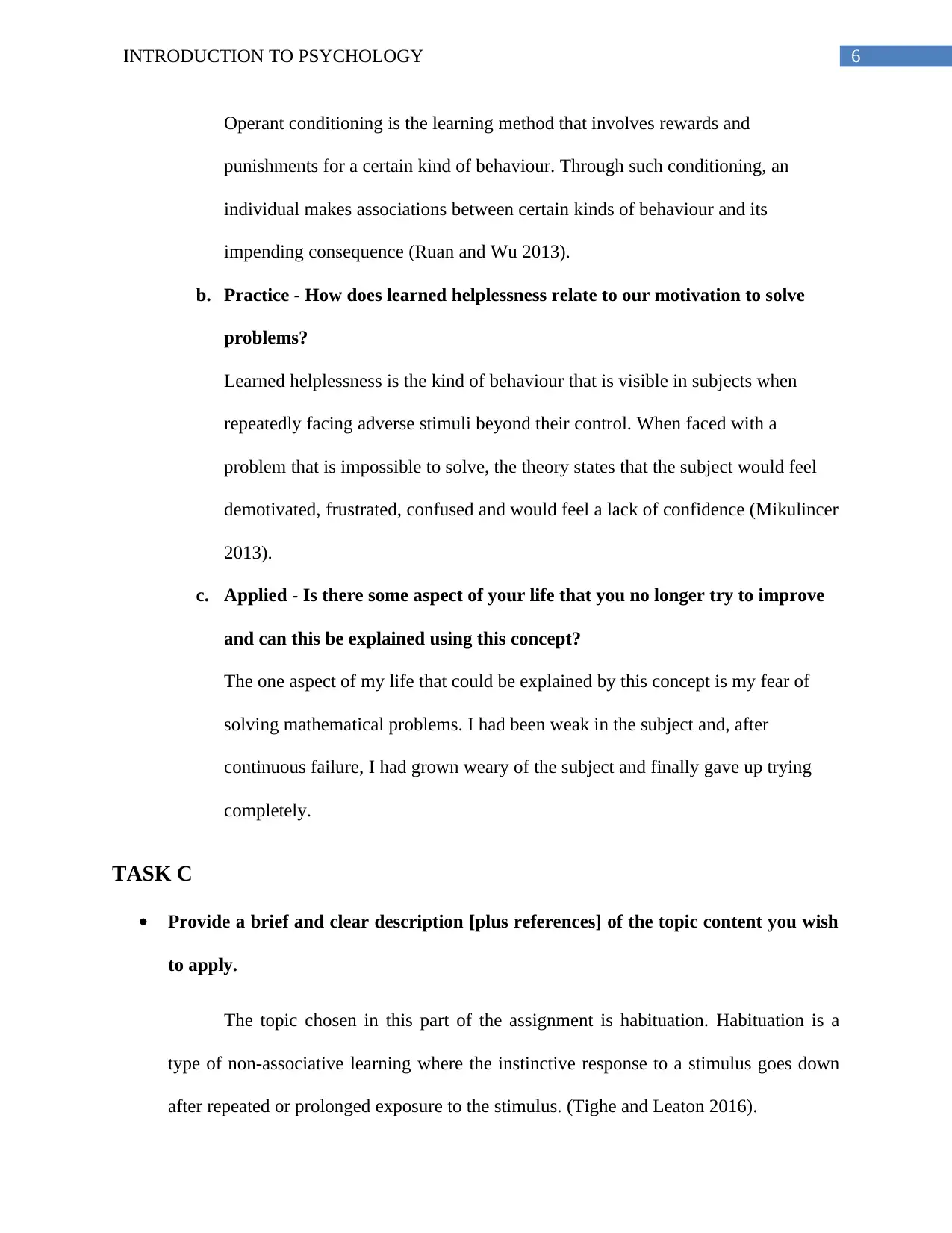
6INTRODUCTION TO PSYCHOLOGY
Operant conditioning is the learning method that involves rewards and
punishments for a certain kind of behaviour. Through such conditioning, an
individual makes associations between certain kinds of behaviour and its
impending consequence (Ruan and Wu 2013).
b. Practice - How does learned helplessness relate to our motivation to solve
problems?
Learned helplessness is the kind of behaviour that is visible in subjects when
repeatedly facing adverse stimuli beyond their control. When faced with a
problem that is impossible to solve, the theory states that the subject would feel
demotivated, frustrated, confused and would feel a lack of confidence (Mikulincer
2013).
c. Applied - Is there some aspect of your life that you no longer try to improve
and can this be explained using this concept?
The one aspect of my life that could be explained by this concept is my fear of
solving mathematical problems. I had been weak in the subject and, after
continuous failure, I had grown weary of the subject and finally gave up trying
completely.
TASK C
Provide a brief and clear description [plus references] of the topic content you wish
to apply.
The topic chosen in this part of the assignment is habituation. Habituation is a
type of non-associative learning where the instinctive response to a stimulus goes down
after repeated or prolonged exposure to the stimulus. (Tighe and Leaton 2016).
Operant conditioning is the learning method that involves rewards and
punishments for a certain kind of behaviour. Through such conditioning, an
individual makes associations between certain kinds of behaviour and its
impending consequence (Ruan and Wu 2013).
b. Practice - How does learned helplessness relate to our motivation to solve
problems?
Learned helplessness is the kind of behaviour that is visible in subjects when
repeatedly facing adverse stimuli beyond their control. When faced with a
problem that is impossible to solve, the theory states that the subject would feel
demotivated, frustrated, confused and would feel a lack of confidence (Mikulincer
2013).
c. Applied - Is there some aspect of your life that you no longer try to improve
and can this be explained using this concept?
The one aspect of my life that could be explained by this concept is my fear of
solving mathematical problems. I had been weak in the subject and, after
continuous failure, I had grown weary of the subject and finally gave up trying
completely.
TASK C
Provide a brief and clear description [plus references] of the topic content you wish
to apply.
The topic chosen in this part of the assignment is habituation. Habituation is a
type of non-associative learning where the instinctive response to a stimulus goes down
after repeated or prolonged exposure to the stimulus. (Tighe and Leaton 2016).
Paraphrase This Document
Need a fresh take? Get an instant paraphrase of this document with our AI Paraphraser
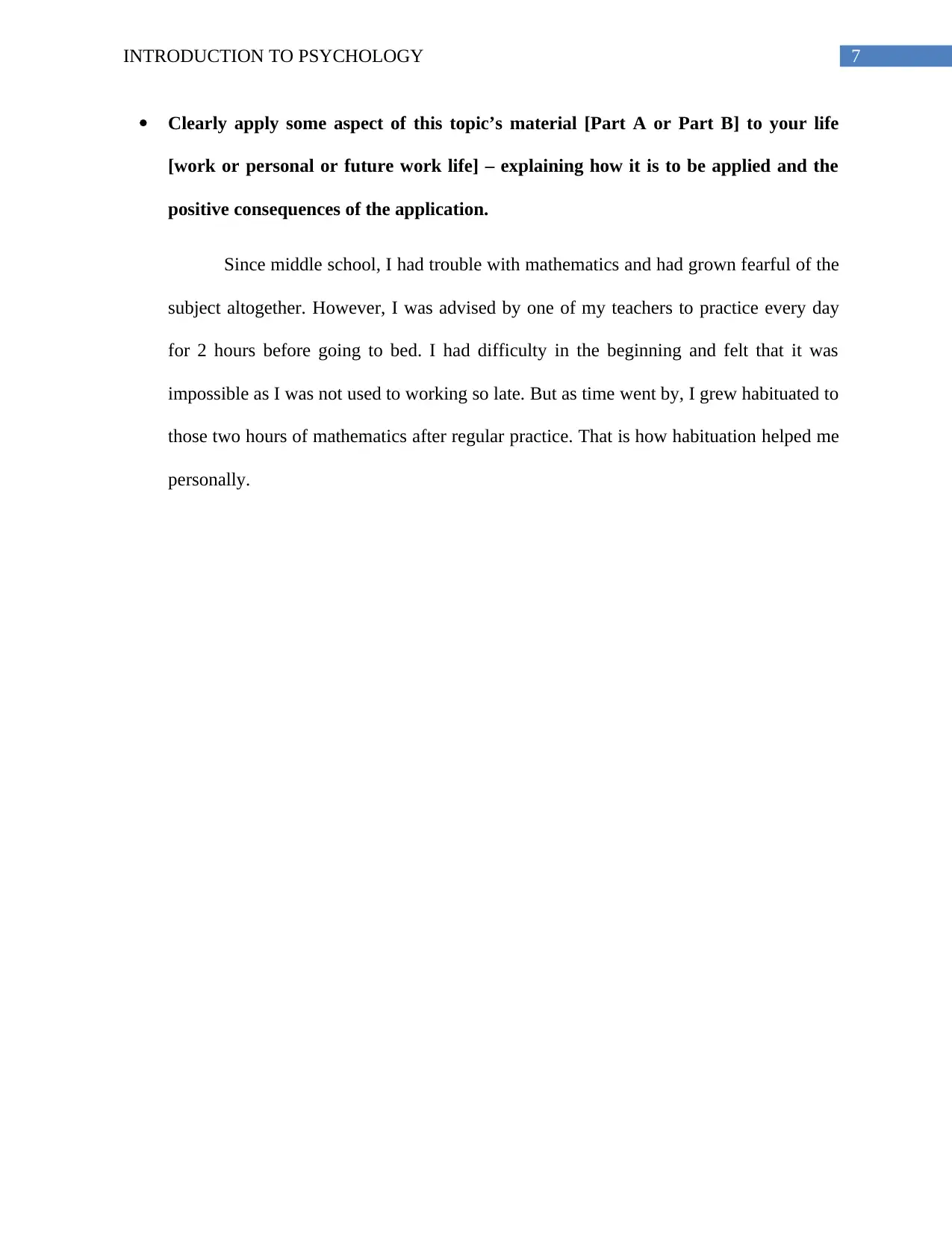
7INTRODUCTION TO PSYCHOLOGY
Clearly apply some aspect of this topic’s material [Part A or Part B] to your life
[work or personal or future work life] – explaining how it is to be applied and the
positive consequences of the application.
Since middle school, I had trouble with mathematics and had grown fearful of the
subject altogether. However, I was advised by one of my teachers to practice every day
for 2 hours before going to bed. I had difficulty in the beginning and felt that it was
impossible as I was not used to working so late. But as time went by, I grew habituated to
those two hours of mathematics after regular practice. That is how habituation helped me
personally.
Clearly apply some aspect of this topic’s material [Part A or Part B] to your life
[work or personal or future work life] – explaining how it is to be applied and the
positive consequences of the application.
Since middle school, I had trouble with mathematics and had grown fearful of the
subject altogether. However, I was advised by one of my teachers to practice every day
for 2 hours before going to bed. I had difficulty in the beginning and felt that it was
impossible as I was not used to working so late. But as time went by, I grew habituated to
those two hours of mathematics after regular practice. That is how habituation helped me
personally.
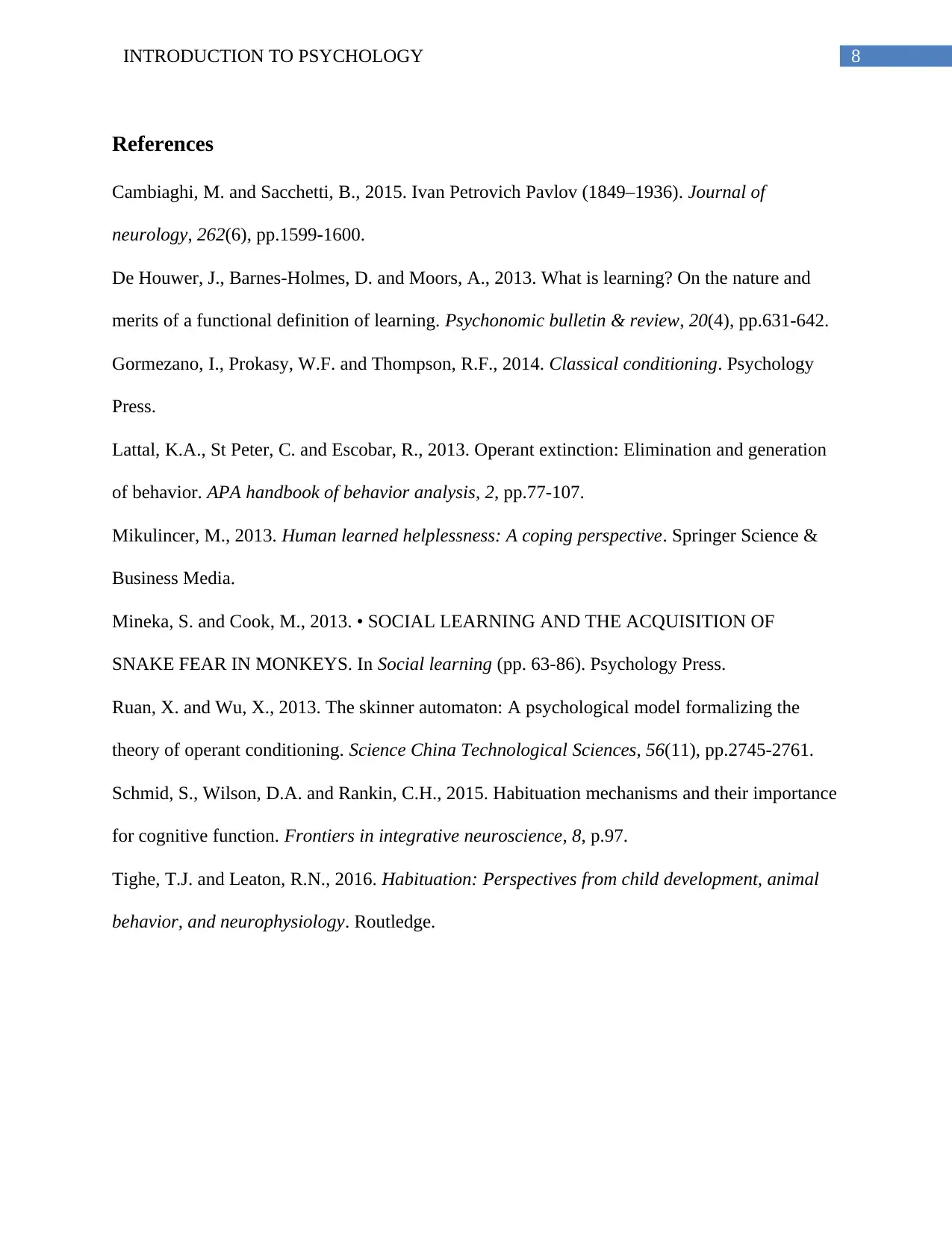
8INTRODUCTION TO PSYCHOLOGY
References
Cambiaghi, M. and Sacchetti, B., 2015. Ivan Petrovich Pavlov (1849–1936). Journal of
neurology, 262(6), pp.1599-1600.
De Houwer, J., Barnes-Holmes, D. and Moors, A., 2013. What is learning? On the nature and
merits of a functional definition of learning. Psychonomic bulletin & review, 20(4), pp.631-642.
Gormezano, I., Prokasy, W.F. and Thompson, R.F., 2014. Classical conditioning. Psychology
Press.
Lattal, K.A., St Peter, C. and Escobar, R., 2013. Operant extinction: Elimination and generation
of behavior. APA handbook of behavior analysis, 2, pp.77-107.
Mikulincer, M., 2013. Human learned helplessness: A coping perspective. Springer Science &
Business Media.
Mineka, S. and Cook, M., 2013. • SOCIAL LEARNING AND THE ACQUISITION OF
SNAKE FEAR IN MONKEYS. In Social learning (pp. 63-86). Psychology Press.
Ruan, X. and Wu, X., 2013. The skinner automaton: A psychological model formalizing the
theory of operant conditioning. Science China Technological Sciences, 56(11), pp.2745-2761.
Schmid, S., Wilson, D.A. and Rankin, C.H., 2015. Habituation mechanisms and their importance
for cognitive function. Frontiers in integrative neuroscience, 8, p.97.
Tighe, T.J. and Leaton, R.N., 2016. Habituation: Perspectives from child development, animal
behavior, and neurophysiology. Routledge.
References
Cambiaghi, M. and Sacchetti, B., 2015. Ivan Petrovich Pavlov (1849–1936). Journal of
neurology, 262(6), pp.1599-1600.
De Houwer, J., Barnes-Holmes, D. and Moors, A., 2013. What is learning? On the nature and
merits of a functional definition of learning. Psychonomic bulletin & review, 20(4), pp.631-642.
Gormezano, I., Prokasy, W.F. and Thompson, R.F., 2014. Classical conditioning. Psychology
Press.
Lattal, K.A., St Peter, C. and Escobar, R., 2013. Operant extinction: Elimination and generation
of behavior. APA handbook of behavior analysis, 2, pp.77-107.
Mikulincer, M., 2013. Human learned helplessness: A coping perspective. Springer Science &
Business Media.
Mineka, S. and Cook, M., 2013. • SOCIAL LEARNING AND THE ACQUISITION OF
SNAKE FEAR IN MONKEYS. In Social learning (pp. 63-86). Psychology Press.
Ruan, X. and Wu, X., 2013. The skinner automaton: A psychological model formalizing the
theory of operant conditioning. Science China Technological Sciences, 56(11), pp.2745-2761.
Schmid, S., Wilson, D.A. and Rankin, C.H., 2015. Habituation mechanisms and their importance
for cognitive function. Frontiers in integrative neuroscience, 8, p.97.
Tighe, T.J. and Leaton, R.N., 2016. Habituation: Perspectives from child development, animal
behavior, and neurophysiology. Routledge.
⊘ This is a preview!⊘
Do you want full access?
Subscribe today to unlock all pages.

Trusted by 1+ million students worldwide
1 out of 9
Related Documents
Your All-in-One AI-Powered Toolkit for Academic Success.
+13062052269
info@desklib.com
Available 24*7 on WhatsApp / Email
![[object Object]](/_next/static/media/star-bottom.7253800d.svg)
Unlock your academic potential
Copyright © 2020–2025 A2Z Services. All Rights Reserved. Developed and managed by ZUCOL.





